Posted by David R.E. Hunt on 12-20-2005 11:40 PM:
How Do I Love Thee, Let Me Count The Colors...
Greetings Everyone
I have recently purchased this antique Ersari juval.
At 34"x50" it is large, and sports a 3x4 layout of huge archtypal major guls
(the first depicted below is 9" wide and 7" tall) and this triangle variant
of a chemche. Real simple kochak border with two barber pole guards. Doesn't
come much simpler than this. The detail of the drawing is superb, I do believe,
and with three blues, an interesting green, red, yellow, brown, ivory and apricot,
quite a range of colors. Thick, dark coarse warps, two shots of weft, 8h. x12
v. open right, flat on the back with no ridges, almost like a Tekke, and a low
pile which is glossy and colors of depth which really respond to light. An interesting
object all around, even smells good.
I suspect this is on the further end of the age spectrum for an Ersari, and
the colors are great (I think?). The deep red, couple shades of blue, the green
and yellow, all textbook older Ersari characteristics, if memory serves. And
especially this apricot color seen in the guls.There is a strong green component
in this light blue, it's almost a bluegreen.You really have to see this chuval
in person to appreciate it, the scale of the design,the depth of the colors.
The difference you see in the two full images is entirely a consequence of the
amount of light . In normal indoor lighting the field is a deep mahogany color,
but bring it into bright light and it becomes this supersaturated red.
This bagface demonstrates some interesting qualities color wise, and I invite
everyone to utilize some of these precepts of color harmony to better understand
color use in this weaving.
Dave
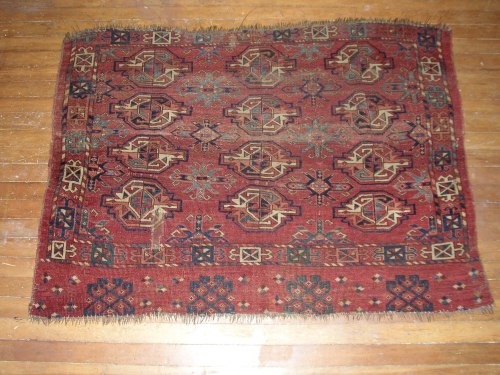
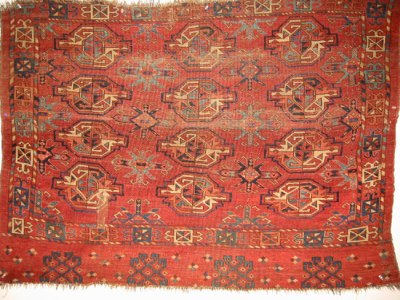
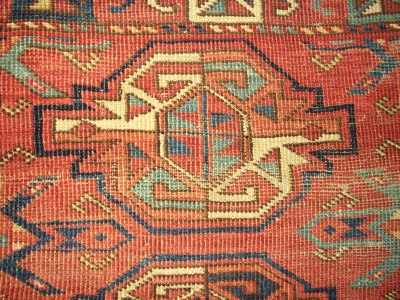
Here is the 9" x 7" archtypal gul. The guls vary much in size and proportion
on this bagface.
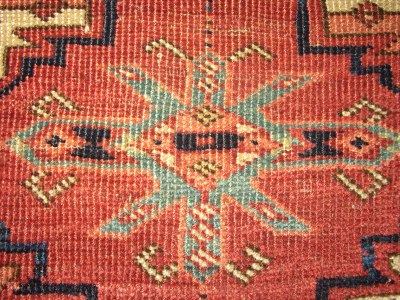
I especially like the detailed use of color in this chemche.
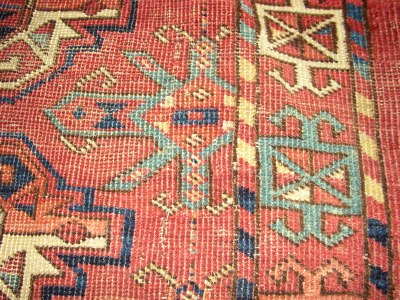
This wonky drawing is endearing.
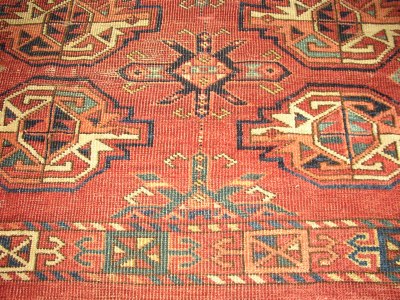
Simple border sequence and this green, both at once.
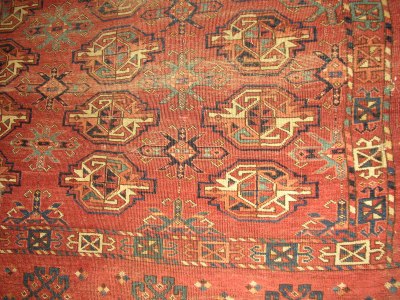
Interesting Elem in this further image.
Posted by R. John Howe on 12-23-2005 05:59 AM:
Hi David -
No one is acknowledging your piece, so let me do so.
As I said on the side, I think this is a good find, the sort of piece that I
often buy myself. Older, but with some condition problems.
You mention the large size and it is surprising how large Ersari chuvals sometimes
are.
It appears to have the more "Caucasian-like" colors that both Ersaris and Yomuts
can exhibit. The "robbin egg blue" is especially prominent and attractive.
The drawing seems traditional to me (I personally like to see "hooks" rather
than "flags" among the devices used in internal drawing of the major guls, although
Pinner and Elena said to me once that "hooks" are not an age indicator. I had
though they might be, since hooks are more complex and seem a prime candidate
for simplification, and flag usages seem to be one of the latter.).
I also think the large devices in the elem are attractive and can't remember
seeing them before (there are some Yomut chuval skirts that have four rather
massive devices like this).
I think this piece a worthy addition to your collection.
Regards,
R. John Howe
Posted by David R.E. Hunt on 12-24-2005 01:47 PM:
Hi John
Thanks for the kind words. As I assume is rather obvious, I am fond of this
bagface. Makes a nice counterpoint to my modern Ersari
chuval .
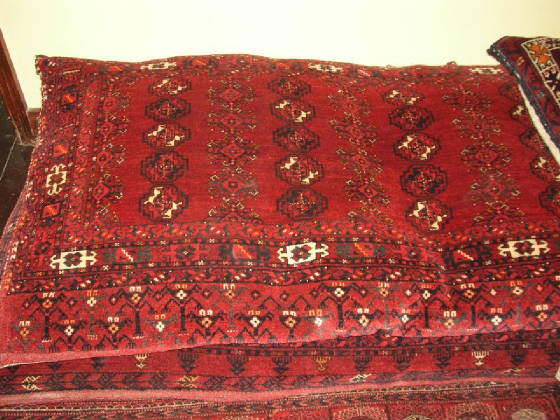
As I had noted above, this antique bagface seems to have most of the distinguishing
characteristics of early Ersari weaving. Another characteristic, as I failed
to note above, is the prominence of white in the palette.
It strikes as a different approach to design than the following,
from your Salon regarding Dennis Dodd's
"Rug Morning" here on Turkotek.

This particular incarnation seems more at Salor than Ersari, compared to their
traditional gul pieces (and especially mine above ).
Any possibility that what we see going on here could be an early attempt to
trade upon the elan of Salor weaving? Barring (or inclusive) of this, representative
of an urban design pool? Some suggest a dichotomy of the Ersari design pool,
consisting of a more western, gul based repetoir and an Eastern, more urban
and Asiatic component.
Follow this link to a previous discussion of design motives in Middle Amu
Darya weaving here on Turkotek.
Your reference to caucasian weaving is interesting, especially in light of what
Eiland has to say concerning the seeming ethnic composition of the Turkmen in
"A complete Guide;
"There are Yomut and Goklan of northeastern Iran who strongly resemble the Kazakhs
of Central Asia. The Salors have a more "Asian" look, giving them an appearence
that more resembles the Uzbekis. The Tekke of Ashkhabad and Merv, however,look
far more Iranian than central Asian."
This elem, with it's four large kochak/lattice devices is for me a high point
in this weaving. In this respect it is unusual, but more at interesting than
odd.
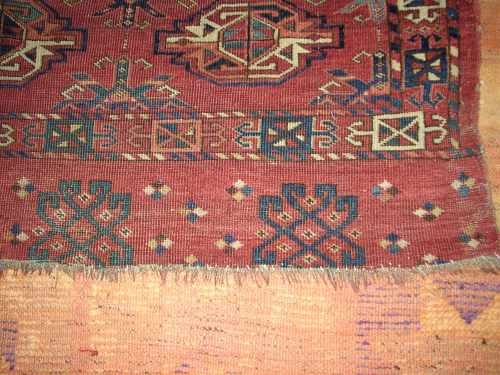
This bagface is difficult (at least for me  ) to photograph, making it challenging to convey the qualities of the colors.
The richness and variability, in accordance to the amount of light, is especially
interesting. Mahogany, Terra cotta, and Tomato are all accurate description
of the ground color under various light conditions. I believe this chuval does
achieve what the color theorists characterize as color harmony, as it can be
argued to demonstrate:
) to photograph, making it challenging to convey the qualities of the colors.
The richness and variability, in accordance to the amount of light, is especially
interesting. Mahogany, Terra cotta, and Tomato are all accurate description
of the ground color under various light conditions. I believe this chuval does
achieve what the color theorists characterize as color harmony, as it can be
argued to demonstrate:
A dynamic balance
Visual interest
A sense of order
The red ground counterpoints the sense of motion conveyed by the real physical
movment, as we fix upon the different colors and elements of the composition,taking
them in. The contrasts in the colors, some of them striking, as in the ivory
and this almost electric blue, is counterbalance by the close filial relationship
between the colors. For all it's apparent complexity, the palette consists of
three representatives of primary blue, one each of the red and yellow primary,
and two tertiaries. Hence the palette relies heavily upon analogous and complimentary
colors. Note the color use in the following chemche gul,

and the positions of the respective colors on the color wheel.

And as for a sense of order, the Turkmen gul format, with it's repetative use
of color in it's borders and guls, is a sense of order of the highest, well,
order.
I picked up this Kirghiz bagface (30" x 41") with the guli gul and kochack border,
dice border and what could be a precursor this stepped "ribbon" border, so often
seen in Ersari and Saryk ( I think?) work. Seems some authors are of the opinion
that Kirghiz weaving is a recent occurence, relative to that of the Turkmen.
The Eilands, in their latest edition of The Complete Guide, view them as being
a potential, elder repository of Turkmen carpet designs.
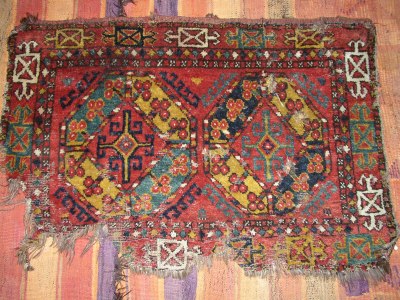

Could these simularities be further manifestations of the Eastern vs Western
dichotomy mentioned above?
Happy Holidays and a Great New Year,
Dave
Posted by Ashok_Patel on 12-30-2005 07:58 AM:
Mr. Dave,
When you write on this discission, "This particular incarnation seems more at
Salor than Ersari, compared to their traditional gul pieces (and especially
mine above )" what do you mean. Where are your comparative salors and what about
these, especially your bedding sack face makes you say salor. This I do not
see. I will be gone for a few days I am taking my wife home to Morocco since
her brother was in an accident. I will try to read the internet from there but
I have no laptop. Maybe I find cyber cafe. Maybe you can give me book name to
see Salor that look like Ersari when I come back. When I think salor I think
of bloomed mader red not browny madder red.
Posted by David R.E. Hunt on 12-31-2005 01:54 PM:
Hi Ashok
It's a reference to the border sequence and it's composition, among others.
I had specifically stated "compared to their traditional gul pieces" as a reference
to design.
Dave
Posted by R. John Howe on 01-04-2006 06:16 AM:
Hi David -
I have to admit I'm not seeing the Salor similarity you mention either. In fact,
the main border on your piece is one area in which it seems to me there are
signs of conventionalization. This border appears in Tekke pieces, in the Saryk
you show here and in Ersaris, as well as in the non-Turkmen Central Asian piece
you also provide. Versions of it appear in some Salor pieces as well (I am looking
at Plates 2 and 5 in Jourdan) but Salor main borders are more often diamond
shaped devices.
Ersari weavings may often not need the support of comparison with the august
Salors. Marla Mallett has said somewhere that as she has examined a great many
Turkmen pieces in recent years, she has found that the oldest instance of a
number devices seems to occur in Ersari pieces. She speculates that Ersari design
may in some instances have served as a kind of source for other Turkmen weavers.
Regards,
R. John Howe
Posted by Ashok_Patel on 01-04-2006 11:44 AM:
Mr. R.,
Very interesting. Did not the Ersari Saltuq rule the Salor but the Salor never
ruled the Saltuq. All Turkmen were ruled by the Ersari except maybe the Yomud.
Who is this Mallet who knows so much?
Posted by Steve Price on 01-04-2006 12:29 PM:
Hi Ashok
Marla Mallett is the author of "Woven Structures", an excellent book about,
well, about woven structures. She's also got a nice website, with loads of information
on it, at http://www.marlamallett.com/
Regards
Steve Price
Posted by David R.E. Hunt on 01-04-2006 09:37 PM:
East vs West, Continued...
Hi John
The similarites I mention are only superficial, just the internal drawing or
"instrumentation" of the archtypal guls and the kochak variant of the border,
as in Plate 6 from T.M's "Turkmen" below.
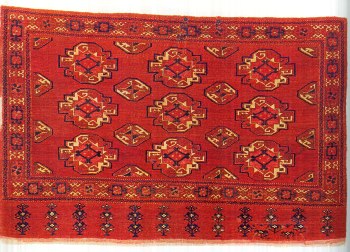
Plate 6, mid 19th cent. Salor Tribe
Don't get me wrong, I dont really understand the process by which these come
to look so much alike. But Thompson has some ideas, as from "Turkmen", pg. 67,
below.
"The oldest weavings of each tribe frequently provide suprisingly clear evidence
of an early relationship between them in terms of their designs. The further
back we look the more comon ground
we find, which points to a common ancestry for many Turkmen designs. As the
awareness of Turkmen weavings has grown and previously unknown old rugs becomw
available for study, similarities between the tribes emerge that are not evident
in later examples.This suggests that some designs have originated
from a common ancestor at some time in the distant past and that these designs
have undergone successive modifications in the hands of different tribes. The
various forms of the quartered-lobed-gul suggests an early relationship between
the Salor,Saryk,Tekke,Ersari, and possibly Arabatchi.
The exact nature of the relationship is not clear. It could be one of geographical
proximity, military alliance, cultural affinity or, as the legendary history
of the tribes would suggest, an origional tribal unity, later subdivided".
Well and good, but for a moment let's go back to plate 6 above, of which Thompson
states
"The design of this bag is interesting for the comparison it provides with literally
hundereds of bags with nine guls made by various tribes, particularly the Yomut,
and with the bag in the following plate which has the same design but in a different
arrangement. The term "archtypal gul" has been coined
for this design so as to avoid a simplistic mistake of calling it by a tribal
name. Every Turkmen tribe uses a form of this design somewhere in it's weaving.
There are so many variations that it is impossible to say what form is ancestral
to annother They must all be derived from a common prototype which has undergone
various modifications over a long period of time in many different hands".
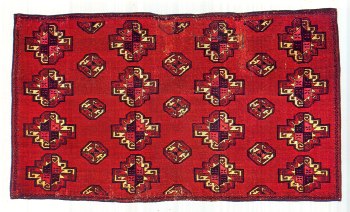
Plate 7, late 18th cent. Salor Tribe
So here we have two formats of gul layout ,the 3x3 and a 4x4.
Let's assume we are moving west and look at a pair of Yomud chuvals, also from
"Turkmen"and as discribed by Thompson.
"Two main streams of design can be detected. The first consists of ancient designs
shared by other Turkmen tribes. This stream is represented by carpets with the
archtypal gul, the dyrnak gul, and the octagonal gul with four pair of animals
the Tauk Noska design. The second stream consists of designs incorporated from
outside sources and changed gradually in conformity with the prevailing Turkmen
style".
"The bag in plate 70 displays an arrangement of three rows of three archtypical
guls. It has no back, but unlike many old bags, retains it's origional width,
including the areas of solid color at both sides beyond the main border. This
empty space is important to the visual effect of the design as a whole".
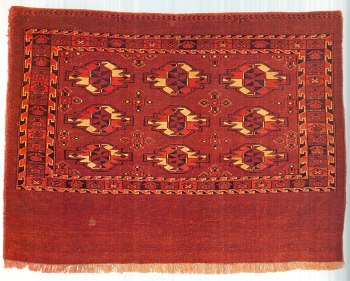
PLate 70, Early 19th cent. Yomud Tribe
"Another variation of the archtypal gul is seen in a Yomit bag where three rows
of four guls occupy the field which is proportionately larger than the previous
example. Another version of the Chemche gul is used for the secondary
ornament. The main border and guard striopes are sometimes found in Tekke weaving".
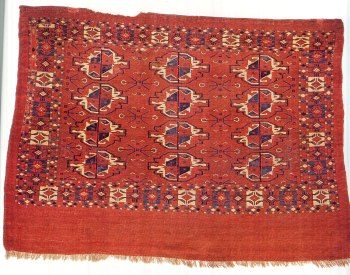
Plate 71, Early 19th cent. Yomud Tribe
Now compare Plate 71, 70 to the Ersari in Question.

I'll come back and try to make sense of this soon.
Dave
Posted by David R.E. Hunt on 01-07-2006 08:30 PM:
East vs West, Continued...
Hi John
Let's step back from the three archtypal guls and their internal drawing for
a while (will come back to these later), and broaden the scope of the discussion.
Let's start with the Kirghiz bagface mentioned above.
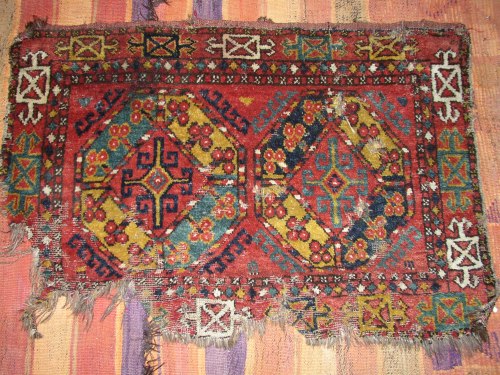
This is really an interesting artifact (and apparently rare, as suggested by
Eiland in "Complete Guide"), with it's coarse weave and expansive scale of design,
the size of the guls on the bagface approximating that on gulli gul main carpets
of the Ersari. Of special note, this diamond shaped "shield" within the gulli-guls
is about the size of a Tekke main carpet gul, and seems to beckon innovation
of design. I suspect it has yielded much.
You could sew four of these Kirghiz bagfaces together and almost have a main
carpet. At 30" x 41 it's a few inches shy of the 32 1/4" x 52 1/2" demonstrated
by the turret gul Salor chuval in "Turkmen's" Plate 8 (below).
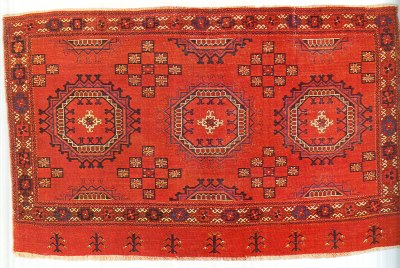
Notice the kochak border, and especially the turrets, common to both the Salor
and the Kirghiz; in the Kirghiz the turrets are suggested as the minor gul,
and it's placement contiguous with the gulli-guls.
The "Ersari" main carpet from T.M."s "Turkmen", Plate 85, is accompanied by
the following caption
"The carpet in Plate 85 has large, closely spaced guls, an arrangement which
conforms to an archaic tradition preserved most noticeably in Ersari weavings.
The grid lines joining the secondary ornaments is unusual and may be the vestige
of an earlier layout. The huge guls are uneven in shape and size, giving the
carpet an early primative look. The colors, wide coarse side finishes, light
colored wefts, and crude workmanship provoke the question of exact Tribal origin.
At first glance it looks Ersari, it certainly has an Ersari design, but the
overall style is close
to a group of colorful, rough-and-ready weavings often considered products of
non-Turkmen weavers".
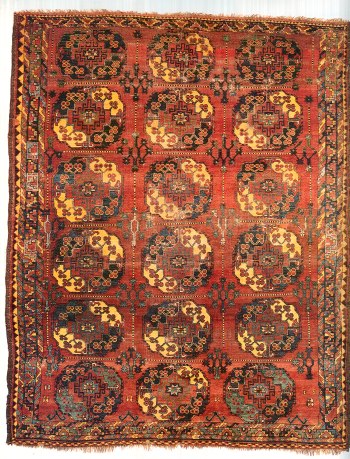
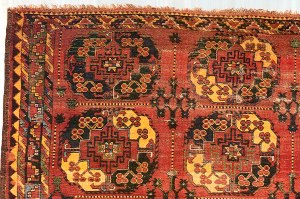
Notice the memling guls at the center of the "shield" device in the gulli-guls.
And compare it to the drawing of the shield region of the archtypal gul from
Thompson, Salor plate 6.
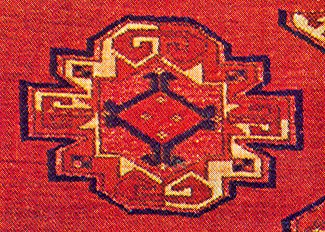
We see this same element here, to the left and right of the central medallion
in this Salor piece,
from "Turkmen" plate 9.
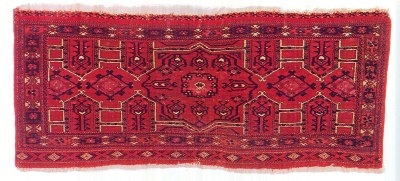
It is not by coincidence that this central medallion is of an octalinear configuration,
as in the minor guls of the following Ersari main carpet, plate 58 from "Black
Desert and Red".
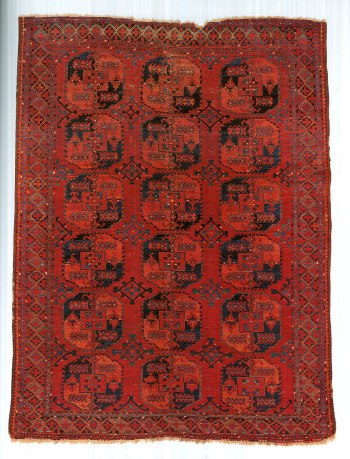
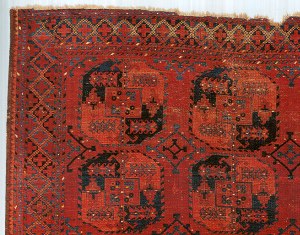
Here the main guls are of a more rectalinear geometry, and the minor gul of
the octalinear.
Thus we have two basic variations upon geometric design progression, rectalinear
and octalinear, and representing the formentioned west/east dichotomy.
Iv'e indicated below just a rough approximation of the forces which have molded
Turkmen design repetoir, the blue line those of the Caspian region and as manifested
in the early palmette style drawing of the Ballard Yomud in the Met. To the
east, in green we have Uzbek and other central asian denizens which make this
area home and who have lived in close proximity to each other for centuries.
And in the center the Turkmen where they have resided for some time as well.
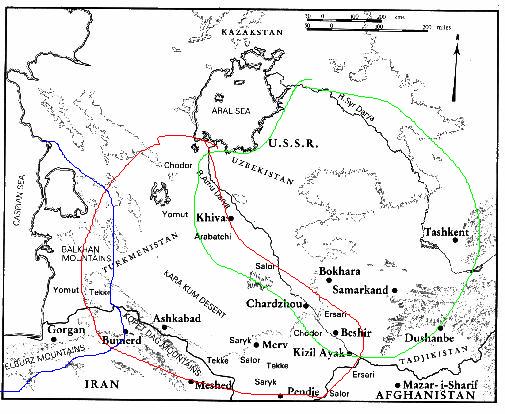
In a detail from an Ersari main carpet in Eiland's "Complete Guide", we see
this eastern, octalinear motif. Notice that the interior "shield" of these Ersari
gulli-guls approximate delineation of the archtypal gul.
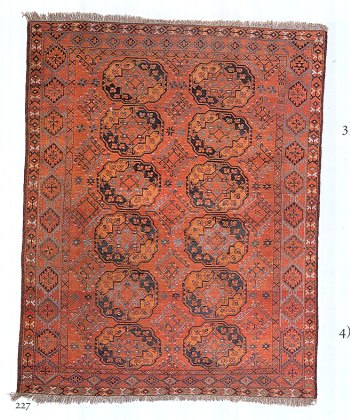
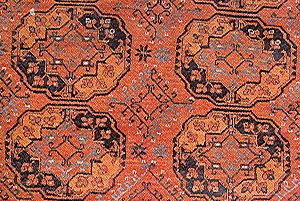
Thus is the geometric relationship between the gulli-gul of the Ersari, it's
compatriots the Turkmen main carpet guls such as the Tekke, and the archtypal
gul ,which share this octalinear geometry. Of the interior drawing of the above
mentioned Yomud archtypal guls from plates 70 and 71, we see a more rectalinear
orientation.


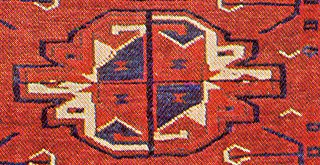
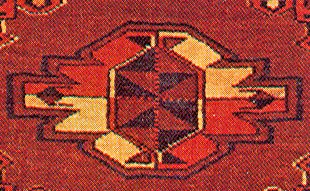
Dave
Posted by David R.E. Hunt on 01-14-2006 10:50 AM:
East vs West, Part III
Hi John
You had stated above that
"Marla Mallett has said somewhere that as she has examined a great many Turkmen
pieces in recent years, she has found that the oldest instance of a number devices
seems to occur in Ersari pieces. She speculates that Ersari design may in some
instances have served as a kind of source for other Turkmen weavers"
and I think this fits well into the discussion of this eastern vs. western,
octalinear vs. rectalinear dicotomy. Find below a Tekke engsi which demonstrates
this more western rectalinear drawing. (Follow this link to a discussion of
the similarity this engsi design bears to traditional Persian flat weaves or
zilus )
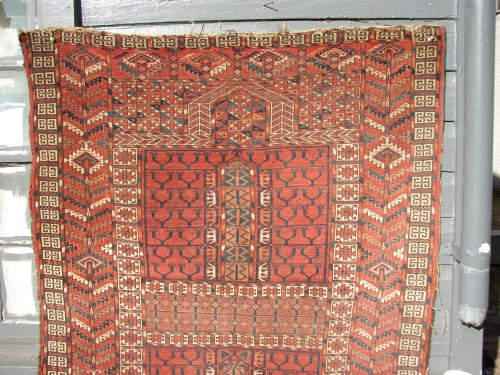
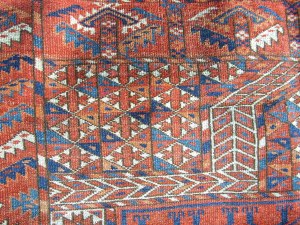
and compare it to the internal drawing of these two guls


I would suggest of these two that the internal drawing of this second Yomud
gul from Thompson plate 70 better represents the western style, with it's simple
"banner" as opposed to the more octalinear "bracket". Yet the "twelve triangle"
design is the same in both.
Maybe this map, from "Between Black Desert and Red" can aid us in understanding
what was going on with these carpet designs.

Notice how all of the population centers ring the edge of the Kara Kum Desert,
and imagine the forces exerted if a fundamental shift in the flow of trade,
to and from the west toward the Caspian, or the reverse, toward Bukhara and
Samarkand, took place.
Interesting that Ikat patterns are found abundantly in both Yomud and Ersari
weaving, yet for some reason seem to prevail later in the designs of the Ersari,
Ikat designs being more prevalent in the Yomud during an earlier period(?).
If we are correct in assuming that the Ikat source lies in the east, this would
suggest the yomud were familiar with Ikat and that they traded with the eastern
cities of Turkestan. Perhaps these tendencies, rectalinear vs octalinear, are
more a consequence of geographic isolation due to shifts in trade routes, population
decline, supply/demand, spread of arid regions, ect..
Dave
Posted by James Blanchard on 01-15-2006 07:43 AM:
Hi David,
Interesting thoughts, though I am not sure how one could substantiate theories
of design "migration" definitively. Still, I think you have highlighted some
important differences within broad design categories.
I don't know very much about Yomud designs during various epochs. Here is a
Yomud rug listed as c. 1900 shown on Barry O'Connell's "spongobongo" website.
Is this an example of Yomud ikat design? Does this represent early or late Yomud
weaving?
James.
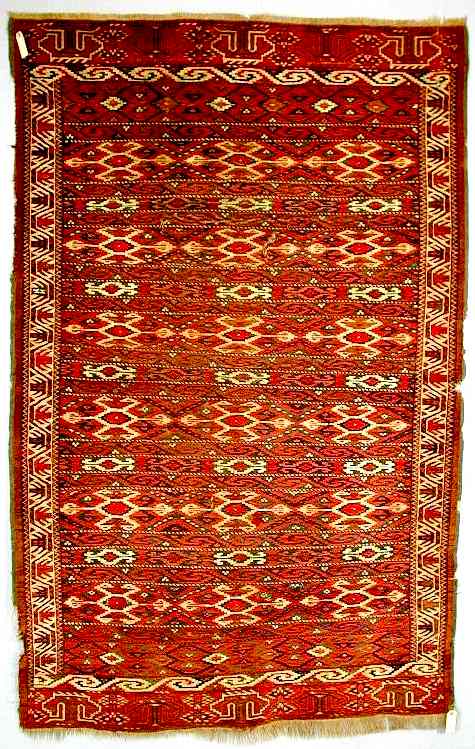
Posted by David R.E. Hunt on 01-15-2006 11:36 AM:
hi James
You had stated that
"I am not sure how one could substantiate theories of design "migration" definitively"
and I agree. I also don't know how to definitively substantiate the Theory of
Evolution, yet it seems a fairly sound proposition.
You could probably construct an analogy of gene pools and design pools, isolation
of traits, isolation of motifs, ect., and while it may not constitute a "definative
substantiation" it seems a valid model with which to examine a natural phenomena.
You gotta go with what youv'e got.
I suspect that your rug draws for it's design from a couple of sources, as with
much Turkmen weaving, including flatweaves, feltwork, possibly ikats, and both
a rectalinear and an octalinear design progression. All are just clusters of
characteristics, which seem to express an affinity for an approximate, gross
geographic distribution of designs and techniques. Is there also a temporal
dimension?
Will be back with more soon.
Dave
Posted by David R.E. Hunt on 01-15-2006 03:13 PM:
Central Asian Gulli-Guls
Hi John, James
The following are various incarnations of the Gulli-Gul found in Central Asia
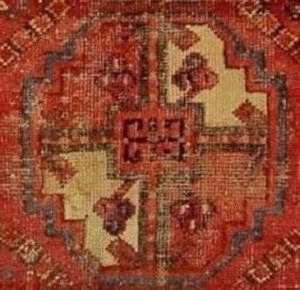
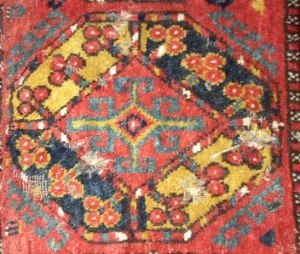
Kirghiz napramach; Kirghiz Gulli-Gul from bagface above;
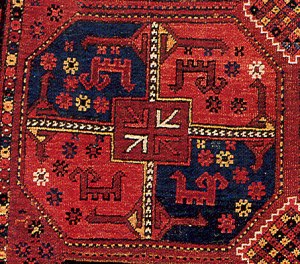
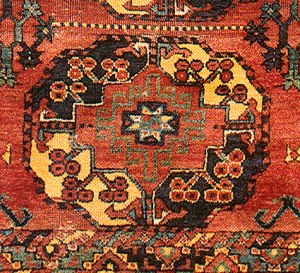
Karakalpak/Uzbek, from "Black Desert" plate 77; Non-Turkmen, from "Turkmen"
plate 85;
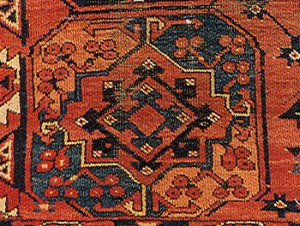
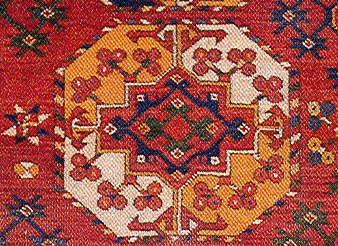
an early Ersari main carpet from "Black Desert" plate 55; an Ersari from "Carpet
Magic" page 37,
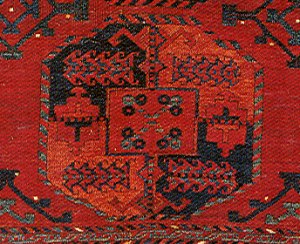
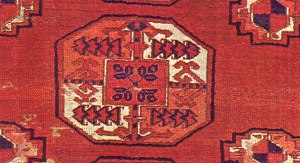
an Ersari with the Temirjin gol;
and it's counterpart in a Saryk carpet fragment; "Turkmen" plate 16;
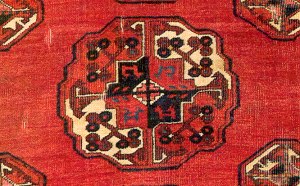
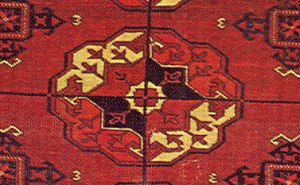
the Salor Gulli-gul; and of course the Tekke.


Interesting, the similarities in construction and drawing found between the
chuval guls above and the Tekke main gul. Could the ubiquitous and stable natures
of these three motives be a function of a kindered history and association?
And of the balance of the Gulli-guls, a more broadly based relationship?
Be sureto check out a thread here on Turkotek, Middle Amu
Darya Weaving, for other apparent examples of design transmission, and from
one medium to another. Scrool about half way down the page (it's a long thread)
to find the referenced material.
Dave
Posted by David R.E. Hunt on 01-19-2006 09:17 PM:
Temporal Dimensions...
Hi James, John
It is important to keep in mind a few basic principals inherent to the study
of Turkestan and in turn Turkmen weaving in general, as postulated by Kalter
in his "Arts And Crafts Of Turkestan".
1. Forms and ornaments which appeared in their characteristic shape for the
first time in the Timurid period have dominated the traditions of the arts and
crafts untill well into our century.(Kalter, pg.39)
2. Items which can be proved to be older than 100 to 150 years are extremely
rare.(Kalter,pg.26)
3. Late medieval cultural traditions have survived untill our own time. This
makes the study of the recent cultures of Turkestan so fertil, but at the same
time so difficult; they can only be understood from a historical point of view.(Kalter,
pg.41)
In short, the cultures of Turkestan have been static since the decay of the
Mongol empires, and it is possible that traditions such as the use of the Palas
as a floor covering and the influences of ikat weaving upon that of pile, may
date to this early period. There is practically no physical evidence, so that
which can be learned must proceed from correlation.
****************************************
A Brief History of Turkestan
Only in the 9th century did independant Islamic states emerge in Turkestan,
at first still formally dependant on the court of the (Arab) Caliph. The most
important of these states, culturally as well as economically, was the Samanid
Empire (874 - 999). The Samanid's capital was Bukhara, their most important
governor's seat was Nishapur.
As documented by tens of thousands of Samanid coins found in Scandanavia, but
also a few scattered ones in Central Europe, Samanid trade, passing via the
Volga basin, reached nearly the whole of europe. The list of export goods made
up by the Arab geographer Mukadasi in the 10th century (Brentjes 1976), is long
and impressive. His (incomplete) list comprises: rugs and prayer rugs from Bukhara
and Samarkand, fine cloths and weavings made from wool, cotton, and silk, soap,
makeup, consecration oil, bows that could only be bent by the strongest men,
swords, armour, stirrups,fittings, saddles,quivers, tents, rasins, sesame, nuts,
honey, sheep, cattle, horses and hawks, iron, sulfer, copper.(Kalter)
Formation of the Turkmen Nation
During the Mongol conquest of Central Asia in the thirteenth century, the Turkmen-Oghuz
of the steppe were pushed from the Syrdariya farther into the Garagum (Russian
spelling Kara Kum) Desert and along the Caspian Sea. Various components were
nominally subject to the Mongol domains in eastern Europe, Central Asia, and
Iran. Until the early sixteenth century, they were concentrated in four main
regions: along the southeastern coast of the Caspian Sea, on the Mangyshlak
Peninsula (on the northeastern Caspian coast), around the Balkan Mountains,
and along the Uzboy River running across north-central Turkmenistan. Many scholars
regard the fourteenth through the sixteenth centuries as the period of the reformulation
of the Turkmen into the tribal groups that exist today. Beginning in the sixteenth
century and continuing into the nineteenth century, large tribal conglomerates
and individual groups migrated east and southeast.
Historical sources indicate the existence of a large tribal union often referred
to as the Salor confederation in the Mangyshlak Peninsula and areas around the
Balkan Mountains. The Salor were one of the few original Oghuz tribes to survive
to modern times. In the late seventeenth century, the union dissolved and the
three senior tribes moved eastward and later southward. The Yomud split into
eastern and western groups, while the Teke moved into the Akhal region along
the Kopetdag Mountains and gradually into the Murgap River basin. The Salor
tribes migrated into the region near the Amu Darya delta in the oasis of Khorazm
south of the Aral Sea, the middle course of the Amu Darya southeast of the Aral
Sea, the Akhal oasis north of present-day Ashgabat and areas along the Kopetdag
bordering Iran, and the Murgap River in present-day southeast Turkmenistan.
Salor groups also live in Turkey, Afghanistan, Uzbekistan, and China.
Much of what we know about the Turkmen from the sixteenth to nineteenth centuries
comes from Uzbek and Persian chronicles that record Turkmen raids and involvement
in the political affairs of their sedentary neighbors. Beginning in the sixteenth
century, most of the Turkmen tribes were divided among two Uzbek principalities:
the Khanate (or amirate) of Khiva (centered along the lower Amu Darya in Khorazm)
and the Khanate of Bukhoro (Bukhara). Uzbek khans and princes of both khanates
customarily enlisted Turkmen military support in their intra- and inter-khanate
struggles and in campaigns against the Persians. Consequently, many Turkmen
tribes migrated closer to the urban centers of the khanates, which came to depend
heavily upon the Turkmen for their military forces. The height of Turkmen influence
in the affairs of their sedentary neighbors came in the eighteenth century,
when on several occasions (1743, 1767-70), the Yomud invaded and controlled
Khorazm. From 1855 to 1867, a series of Yomud rebellions again shook the area.
These hostilities and the punitive raids by Uzbek rulers resulted in the wide
dispersal of the eastern Yomud group. (Library of Congress Country Studies)
Textiles
"The cultivation of cotton, which had origionally been imported from India,had
a centuries old tradition, too. Cotton growing and sericulture (silkworms) were
the foundation on which the flourishing textile workshops in the towns of Turkestan
depended. Cotton has been an important export article since before the Russian
conquest. As early as 1880, the long-fibered American cotton-plant was introduced
by the Russians and areas of cotton cultivation were considerably enlarged.
A great number of irrigation projects, particularlly those carried out after
1920, aimed at the extension of cotton growing. Today, two thirds of the Soviet
Union's cotton harvest is gathered in the Republic of Uzbekistan. Cotton growing
in Turkestan made possible the rise of Russian textile manufacture. As early
as the last decades of the 19th century, cheap Russian cotton printed fabrics
were beginning to supplant the products of the traditional Turkestan textile
workshops more and more, bringing them almost to a standstill, except for the
production of ikat materials with very simple decoration. (Kalter, pg.16)".
Better represented in western collections is ikat, an outstanding product of
Turkestan textile handicrafts. This was put to a variety of uses in Turkestan
households as table cloths, niche curtains, tapestries, bedclothes, covers and
cushion covers.
"According to the literature, in Turkestan, silk and mixed silk/cotton fabrics
are called"abra" or "adra", in Afghanistan (according to Janata), generally
"pardah" (meaning a curtain)."and,
It's exremely varied patterns range from simple stripes to zigzag patterns through
curved lines, to hooks, "cloudband" and circular ornamentation, classic Islamic
motifs such as combinations of stars and crosses, reminescent of Seljuk tiling,
realistic and abstract human figures and trees of life. Despite the credible
work of the important reasearcher in the field of folk textiles, Alfred Buhler,
and an article by A. Janata published in 1978, this fascinating field has barely
been touched in my opinion. The authoritatitive monograph on central Asian ikat
still remains to be written. Buhler assumes- and this
assumption is supported by Janata- that ikat was already produced in Turkestan
in the 8th cent. A.D. The immense number and variety of patterns used in ikat
offer an as yet undeciphered pattern book on which the cultures with which Turkestan
had contact (China,Tibet,India ,Iran) may have left their mark. .
The word "ikat" originated in indonesia. This method of fabric dyeing, like
batik, is a so called "resist" or "reserve" technique, and was developed to
a high degree of perfection there. According to the literature, in Turkestan,
silk and mixed silk/cotton fabrics are called"abra" or "adra", in Afghanistan
(according to Janata), generally "pardah" (meaning a curtain).
To make ikat, the yarn is stretched on the loom. The work is described by Janata
as follows: "In the present case, the threads of the warp are dyed before weaving
by tying them together in bundles according to the desired pattern. A material
of several colors requires several binding and dyeing processes. Since it is
impossible to tie the bundles so tightly that sharp outlines are produced, ikat
weaves can be recognized by the way the colored sections flow in the direction
of the patterned threads. One ikat weave requires the services of nine specialists,
from spinning the silk yarn to weaving. In other places, for simpler products,
fewer sufficed. It is not yet clear who made the ikat fabrics. The repeated
expressed theory that it was made by Jews has not been substantiated. Janata's
conclusion that they were made by Tadzhiks (Arab ethnics) is the most probable,
especially since all the data relating to what craftsmen belonged to which ethnic
groups, indicate most of the craftsmen practising technically sophisticated
crafts were in fact Tadzhiks.
The importance of ikat in urban culture has been described by D. Dupaigne as
follows: Ikat fabrics are luxuries given as gifts of honour at weddings and
other important occasions. The wealth of a landlord or merchant is indicated
by the richness or newness of his garb. The patterns change anually with the
fashion."
P.S. I should note that a recent publication on the subject of ikat, Kate Fitz
Gibbon and Andrew Hale, Ikat: Splendid Silks of Central Asia: the Guido Goldman
Collection (Lawrence King Publishing in Association with Alan Marcuson Publishing,
1999)
***********************************
The following is from a Salon here on Turkotek, The Turkmen
Brocaded Palas as Pile Woven Gul Format Prototype
More Palas
Pictures supplies some interesting comparisons.
Brocade Based Patterns in Turkmen Weaving
Pile woven examples of Palas brocade patterns seem to be straight forward enough,
and there seems to be a high correlation of design elements between the two
groups. Given the propensity for weavers to imitate tile work and engraved patterns,
and in turn for there to be numerous examples of tile and stone engraving imitating
carpet, it seems matter of course that pile floor coverings would imitate the
patterns of brocaded floor coverings as in the palas. That the palas repesents,
as Mr.Slattery contended in the most important "More Palas Pictures" thread
of this salon, "clearly the most basic type of floor covering to be found in
this part of Central Asia" , and in keeping with Kalter's principal #3 above,
which would assert that the palas has been as such since the late middle ages,
further the plausibility that Turkmen gul patterns and symmetry mimic brocaded
Palas patterns and symmetry.
Ikat Weave, from a thread in the above Salon "The Lattice"
It seems that a large number of Turkmen weavings fall into this class, weavings
possessed of patterns and designs which mimic the patterns of ikat cloth, which
itself is so important in this part of the world and which has an extensive
history of production in the Turkmen regions.The size of this class of weavings
speaks much of the importance of ikat, so esteemed and imitated.
The similareties between the two, Ikat and pilework, are many, but this discussion
will center upon two characteristics or qualities of construction and design,
those of warp based design and the symmetry of design.
It is entirely of coincidence that both the ikat and the pile woven rug should
both be of a warp based design structure, in which the design is applied to
the warps by way of dying sections of the warp in ikat, and by attaching dyed
knots of wool to the warp strands in the pile weave. However, it is no coincidence
that the patterns of the two fabrics share the same symmetry, for this characteristic
of being a warp based design both expedites the borrowing of designs and symmetry
and encourage the transaction, by way of simplifying of the process by which
patterns can be transcribed from one medium to the other.
The symmetry of design, between ikat and the pile woven gul format, is perhaps
even better demonstrated by considering the process by which the design is layed
out upon the ikat warps by a technique of halving and folding the warps upon
themselves in order to form a repeating pattern. The following simple demonstration
will clairify this process.
Take an 8 x 11 sheet of standard paper and folds it in half along it's length.
Then fold it again lengthwise. Take the resulting narrow strip and fold it in
half along its narrowest boundry, then fold the resulting rectangle again, across
it's shortest dimension. Now crease the paper heavily upon the edges, and then
unfold it to reveal the perfectly symmetrical grid. The grid which shares the
symmetry of the Turkmen gul format design. Simplicity in itself, this temporal
exercise in design symmetry. Follow this link to another previous discussion
of the ikat/gul
format relationship here on Turkotek.
If you are really a glutton for punishment, check out my other excruciating
Salon, containing some pertinant information regarding Arab cultural inflluences,Streams of
Influence: Motives and Origins of Moroccan Carpet Design.
Dave
Posted by David R.E. Hunt on 01-22-2006 11:25 PM:
East vs. West, Part IV
Hi John, James
Let's return to this east-west dichotomy once again. I had stated above that
"Interesting that Ikat patterns are found abundantly in both Yomud and Ersari
weaving, yet for some reason seem to prevail later in the designs of the Ersari,
Ikat designs being more prevalent in the Yomud during an earlier period(?).
If we are correct in assuming that the Ikat source lies in the east, this would
suggest the yomud were familiar with Ikat and that they traded with the eastern
cities of Turkestan. Perhaps these tendencies, rectalinear vs octalinear, are
more a consequence of geographic isolation due to shifts in trade routes, population
decline, supply/demand, spread of arid regions, ect.."
and seem to have found some correlation in Elena Tsareva's discussion of the
S.M. Dudin collection at Oriental Rug Review
as follows:
Dudin could not study Yomud carpet weaving at this place at the time of the
year. He arrived as the tribe was migrating to summer pastures, and there was
no opportunity to follow them. The only source of rugs were the bazaars of Samarkand
and Merv, neither very rich in Yomud production. So Dudin's impressions of this
group is illustrated only by what was available in the Ferghana Valley.
"Yomud carpets are rarely met at the markets in comparison to Merv or Akhal
Tekkes; most are small pieces, often camel trappings for weddings, asmalyks,
mafrashes, ensis, kapunuks and lastly the runners, yolami.
"In coloring, mainly by common tint and decoration, all articles usually called
Yomud can be divided into several groups. They include products of the Goklan,
Chodor, Ogurjali and so on, and undoubtedly it would be possible to find distinctive
features at least for the most typical objects of these groups if there were
a richer variety of material, at least partly more or less correctly dated."
These two citations from Dudin's article are evidence of the state of knowledge
of Yomud carpet weaving at the eve of the century. Dudin, like most scholars,
could not visit the Yomuds, had no real information on the nature of their weaving,
nor their trade contacts with Iran and the Caucasus. In reality the Yomuds produced
a great number of carpets, mostly in large dimension, for sale. But their markets
were not Samarkand or Bukhara, but the trade centers of the Caucasus and Transcaucasus.
It is known, for example, that it was a question of prestige for Azerbaijanis
to have Turkoman -- or as they were called "velvet" -- carpets in the dowry.
There was some speculation above for the prospect of
"constructing an analogy of gene pools and design pools, isolation of traits,
isolation of motifs, ect., and while it may not constitute a "definative substantiation"
it seems a valid model with which to examine a natural phenomena. You gotta
go with what youv'e got"
and it seems that someone has taken this idea one step further. In their
Investigating cultural evolution through biological phylogenetic
analyses of Turkmen textiles , published in the Journal of Anthropological
Archaeology, Jamshid Tehrani and Mark Collard attempt a statistical analysis
of the frequency of expression, distribution, and filial relationships of design
motives in Turkmen weaving. The following is a sample,
"In contrast to the ethnohistorical evidence, the other two lines of evidence
support the hypothesis of relationships suggested by the textile data. One line
of evidence is the clan names used by the tribes. According to wood (1973),
the Ersari, Saryk, and Salor clan names are derived from an exclusively Oghuz
lexicon, whereas the Tekke and the Yomut clan names include Persian influences.
Moreover, the Ersari, Salor, and Saryk have a number of Oghuz clan names in
common that they do not share with the Tekke or Yomut. Thus, the clan names
support the hypothesis of relationships derived from the textile data, since
they also suggest the Ersari, Salor, and Saryk are more closely related to one
another than any of them is to the Tekke or Yomut. The other line of evidence
that supports the textile data-derived hypothesis of relationships is the geographic
distribution of tribes. As shown in Fig.1, the Ersari, Salor, and Saryk lived
close to the oasisi at Sarakhs and Bokhara, while the Tekke and Yomut lived
in Khorassan. Given the fact that there is a strong statistical tendancy for
territorial groups to coincide with descent groups (Irons,1974), this distribution
supports the suggestion that the Ersari, Salor, and Saryk are more closely related
to one another than any of them is to the Tekke or the Yomut"
of what can be found in this trove of information on Turkmen weaving. While
anyone short of an anthropologist will find much here impenetrable (myself included),
it's interesting, especially in relation to the subject at hand.
Dave
Posted by David R.E. Hunt on 01-27-2006 08:39 PM:
Cavalcade of Ersari Main Carpets
Hi John
Just some scans of Ersari Main carpets. These really are a cornucopia of Turkmen
design
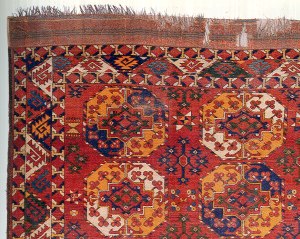
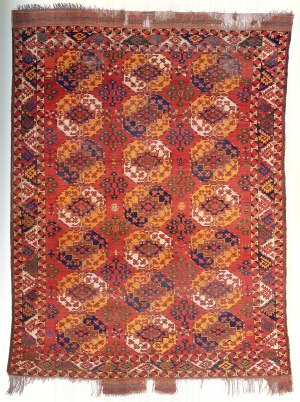
Ersari, from "Carpet Magic" page 37.
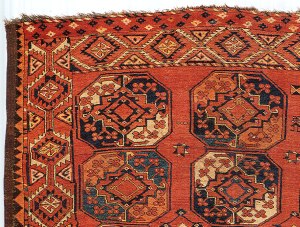
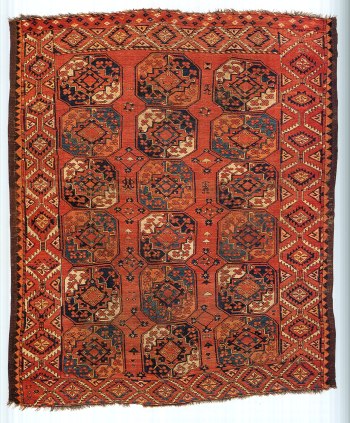
Ersari, from "Between Black Desert and Red" plate 55.
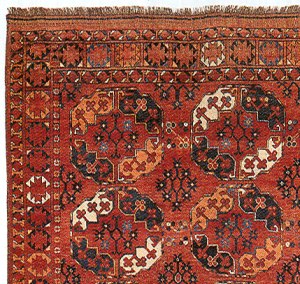
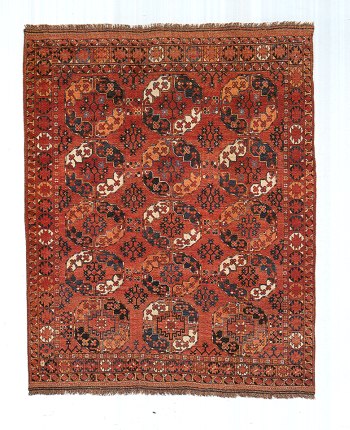
Ersari, from "Between Black Desert and Red" plate 56.
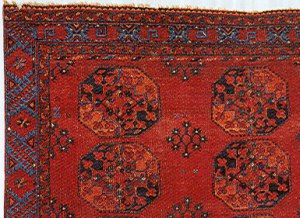
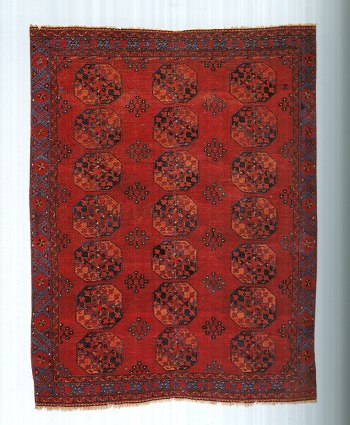
Ersari, from "Between Black Desert and Red" plate 57.
Dave
Posted by David R.E. Hunt on 01-30-2006 10:00 AM:
East vs West Part V
Hi John, James
Let's take a look at what Richard E.
Wright has to say about this
engsi.

"Engsis have somewhat different sizes, bear an essentially uniform design, vary
in secondary and minor motifs, and reflect the properties (weave, yarn, color)
alleged (the underpinning links are quite shaky) to characterize the anything
but monolithic principal Turkmen confederations. That these groups employed
a common pattern fits well with their 17th century co-location on the Mangishlak
peninsula prior to having been pushed out by Kalmuks5 and scattered along the
Amu Daria river to the northeast as well as along the base of the Elbruz mountains
(Asgabad and beyond) to the southeast. (Figure 1) The pattern’s persistence
among these subsequently widely scattered and to some extent isolated clans
suggests that the design may be fundamental. There is some thought that it is
old;6 recent carbon dating studies underscore this possibility."
Of primary significance, this statement
"bear an essentially uniform design, vary in secondary and minor motifs, and
reflect the properties (weave, yarn, color) alleged (the underpinning links
are quite shaky) to characterize the anything but monolithic principal Turkmen
confederations"
for it suggests, that just as with these little triangles used as the structural
"building blocks" of rectalimear designs, the engsi format is used by both eastern
and western weavers, and in the case of the engsi, dates to the 17th century.



The significance of last image of a Tekke gul, which hasundergone little change
in the course of it's long history,lies not only in it's being rendered utilizing
these triangular, hence rectalinear building blocks, but especially for thefact
that this rectalinear method is used to realize an octalinear design. Consider
thefollowing
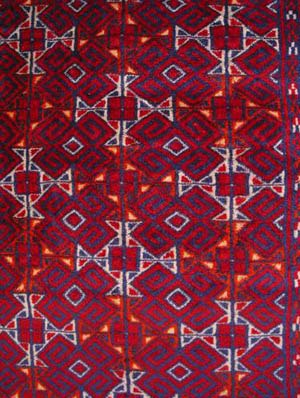
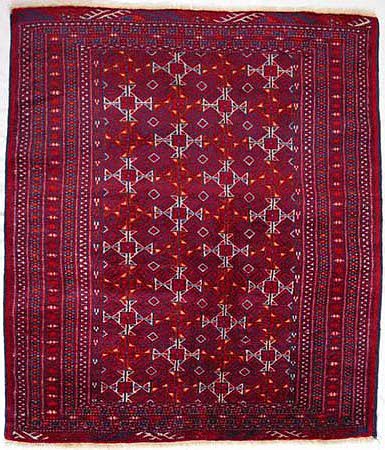
from the thread Hash
Gul Story here on Turkotek, and that notice how the rectalinear "triangle"
units are used to render the fundamentals of an octalinear pattern. I would
suggest that this Hash gul pattern is about as close as you can get to an archtypal
Turkmen design. Even the basic layout, with rows of guls and borders, is rectalinear
in nature.
Be back to finish this soon.
Dave
Posted by David R.E. Hunt on 01-30-2006 10:43 AM:
From the West...
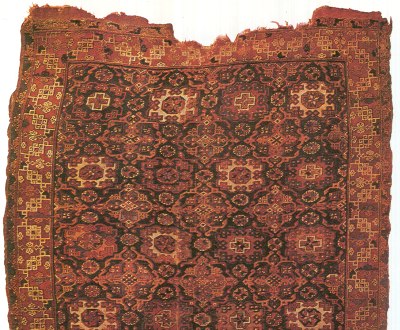
Gantzhorn, ill. 365
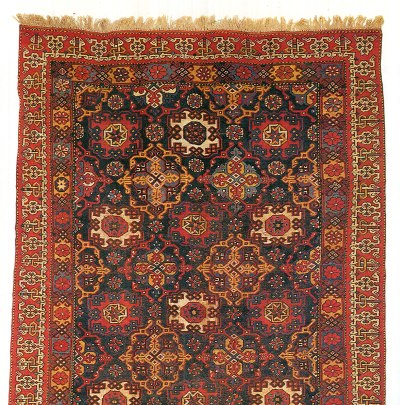
Gantzhorn, ill. 367
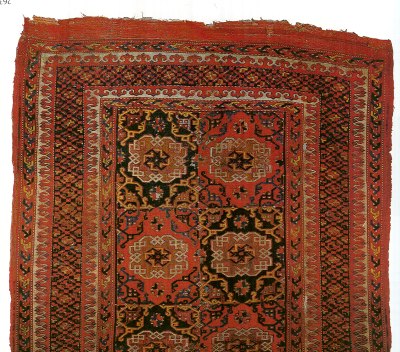
Gantzhorn, ill. 378
Find above the primary suspect for early Turkmen carpets, produced during a
two hubndred year period spanning the 15th and 17 th centuries. How might these
and the following be related?
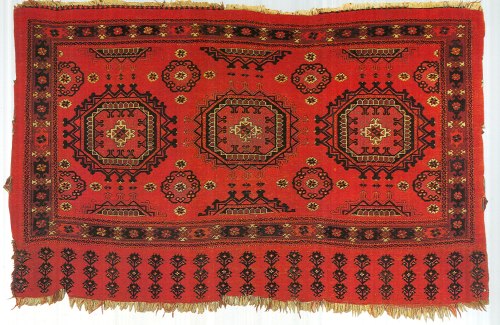
Gantzhorn ill.684
Dave
Posted by David R.E. Hunt on 01-30-2006 01:52 PM:
Rise and Fall of Textiles...
Hi John
In their phylogenic analysis above, Tehrani and Collard begin their introduction
by stating that
"The extent to which the evolution of culture is analogous to biological evolution
has been the subject of considerable debate in recent years, as has the corollary
issue of linking patterns in the ethnographic and archaeological records with
and linguistic data"
and conclude with the assertion that
"phylogenesis was the dominant process in the evolution of Turkmen carpet designs
prior to the annexation of their territories, accounting for 70% of the resemblances
among woven assemblages. The analyses also show that phylogenesis was the dominant
process after 1881, although ethnogenesis accounted for an additional 10% of
the resemblances among the assemblages. These results do not support the proposition
that ethnogenesis has always been a more significant process in cultural evolution
than phylogenesis".
Thus it seems fair to generalize that the Turkmen rather more adapt external
design to their own style or method of weaving, than internalize foreign designs
or methods.
Given that they are kindered entities, this dichotomy even extending to language,
( in which the Turkmen speak a West Turkic dialect, and the balance of Uzbek,
Kirghiz, ect., an East Turkestan dialect) is it fair to extropolate from the
Turkmen data that Kirghiz designs are rather more phylogenic than ethnogenic?
And if so, how do we explain the central relationship inherent in these two
primary designs?

Kirghis Gul

Tekke Gul
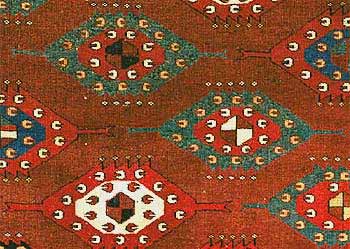
Yomud Gul
I suggest a model, common to the experiences of both people, Uzbek and Turk,
Eastern and western, and centered around the cities of Turkestan.
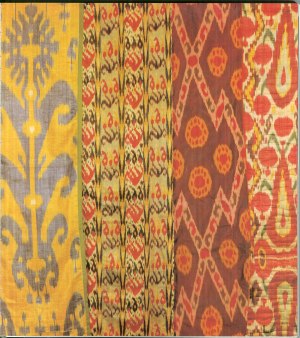
Ikat
Remember, that according to Khalter
"Bukhara and Samarkand were cities to equal other centres of the Islamic world
like Cairo, Baghdad, or Isfahan. They belonged to the most important cultural
centers of the Islamic World"
and,
"Due to the political decay of Turkestan and it's shift from the centre of a
huge world empire in the 14th century to an isolated peripheral situation, late
medieval cultural traditions survived untill our own time. This makes the study
of the recent cultures of Turkestan so fertil, but at the same time so difficult;
they can only be understood from a historical point of view",
also
"one has been accustomed to seeing Turkestan as a country on the periphery,
in a dead area of the worlds history. However, this is a late historical development.
During the longest period in it's history which we can consider Turkestan was
a country situated in the centre, a country that was traversed by peoples, merchants,
and armies. This undoubtedly brought a lot of unrest and suffering, but also
long periods of affluence and brilliant culture"
and I suspect this Tekke Guli gul to be a relic of this distant, textile based
culture in which ikat seems to have played a long and important role. With,
as discribed by Khalter,
"It's exremely varied patterns range from simple stripes to zigzag patterns
through curved lines, to hooks, "cloudband" and circular ornamentation, classic
Islamic motifs such as combinations of stars and crosses, reminescent of Seljuk
tiling, realistic and abstract human figures and trees of life"
is the Tekke Gulli gul as seen in the Tekke main carpet design,
an ikat pattern in the form of an arabesque?
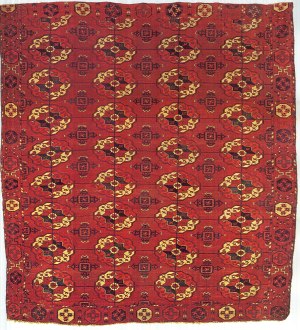
Dave
Posted by David R.E. Hunt on 01-30-2006 02:49 PM:
Rectangles vs Octagons
Hi John
But what does all this tell us about this Ersari chuval?
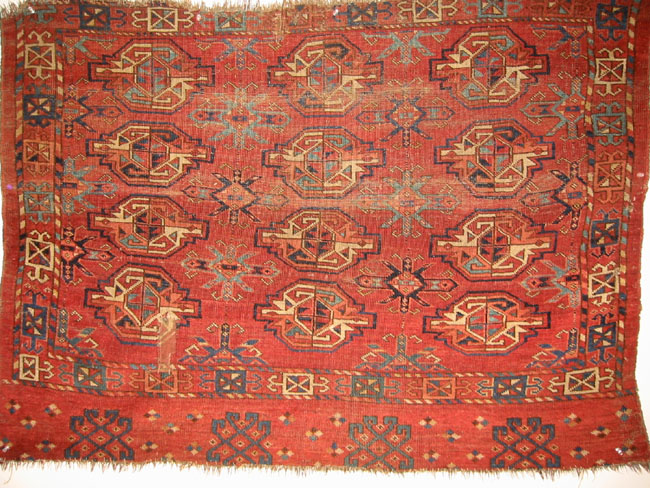
The manner of the drawing,and especially the use of this "triangle" structure
in the chemche gul and elsewhere says to me either a more western geographic
origin, an earlier period of manufacture, or both, as we read from Thompson
above
"The oldest weavings of each tribe frequently provide suprisingly clear evidence
of an early relationship between them in terms of their designs. The further
back we look the more comon ground
we find, which points to a common ancestry for many Turkmen designs. As the
awareness of Turkmen weavings has grown and previously unknown old rugs becomw
available for study, similarities between the tribes emerge that are not evident
in later examples.This suggests that some designs have originated from a common
ancestor at some time in the distant past and that these designs have undergone
successive modifications in the hands of different tribes"
and the unusual devices of the elem say much the same as well. I suspect this
chuval to be an early example of Ersari weaving, based upon the information
I have at my disposal, but it's just an estimate.
Follow this link to a discussion of Ersari Chuvals by David Reuben
Dave










 ) to photograph, making it challenging to convey the qualities of the colors.
The richness and variability, in accordance to the amount of light, is especially
interesting. Mahogany, Terra cotta, and Tomato are all accurate description
of the ground color under various light conditions. I believe this chuval does
achieve what the color theorists characterize as color harmony, as it can be
argued to demonstrate:
) to photograph, making it challenging to convey the qualities of the colors.
The richness and variability, in accordance to the amount of light, is especially
interesting. Mahogany, Terra cotta, and Tomato are all accurate description
of the ground color under various light conditions. I believe this chuval does
achieve what the color theorists characterize as color harmony, as it can be
argued to demonstrate:

















































